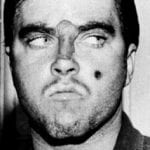 Music
Music  Music
Music  History
History 10 Less Than Jolly Events That Occurred on December 25
 Weird Stuff
Weird Stuff 10 Funny Ways That Researchers Overthink Christmas
 Politics
Politics 10 Political Scandals That Sent Crowds Into the Streets
 Weird Stuff
Weird Stuff Ten Bizarre Facts About The Doge Meme
 Our World
Our World 10 Ways Your Christmas Tree Is More Lit Than You Think
 Movies and TV
Movies and TV The 10 Coolest Stars to Set Sail on The Love Boat
 History
History 10 Things You Didn’t Know About the American National Anthem
 Technology
Technology Top 10 Everyday Tech Buzzwords That Hide a Darker Past
 Humans
Humans 10 Everyday Human Behaviors That Are Actually Survival Instincts
 Music
Music 10 Surprising Origin Stories of Your Favorite Holiday Songs
 History
History 10 Less Than Jolly Events That Occurred on December 25
 Weird Stuff
Weird Stuff 10 Funny Ways That Researchers Overthink Christmas
Who's Behind Listverse?

Jamie Frater
Head Editor
Jamie founded Listverse due to an insatiable desire to share fascinating, obscure, and bizarre facts. He has been a guest speaker on numerous national radio and television stations and is a five time published author.
More About Us Politics
Politics 10 Political Scandals That Sent Crowds Into the Streets
 Weird Stuff
Weird Stuff Ten Bizarre Facts About The Doge Meme
 Our World
Our World 10 Ways Your Christmas Tree Is More Lit Than You Think
 Movies and TV
Movies and TV The 10 Coolest Stars to Set Sail on The Love Boat
 History
History 10 Things You Didn’t Know About the American National Anthem
 Technology
Technology Top 10 Everyday Tech Buzzwords That Hide a Darker Past
 Humans
Humans 10 Everyday Human Behaviors That Are Actually Survival Instincts
10 Love Stories That Ended In Murder
Dan McCafferty once said that love hurts. Well, that’s a bit of an understatement. Love can kill. Throughout history, rejected Romeos and jilted Juliets have dealt with heartache by filling bodies full of lead and leaving corpses in their wakes.
10 The Murder Of Gaston Calmette

Paris is “The City of Love,” but wherever you find amour, you’re bound to find murder. Take the story of Henriette Raynouard for example. In 1911, the French socialite married Joseph Caillaux, a career politician and notorious Casanova who’d dumped his first wife for the lovely Henriette after he became prime minister.
As a member of the center-left Radical Party, Joseph made quite a few enemies thanks to his pro-German policies, but even after he left office in 1912, he remained an influential figure. That didn’t sit well with Gaston Calmette, the editor of Le Figaro and one of Caillaux’s biggest critics. Convinced Joseph was a threat to France, Calmette planned to destroy his reputation.
In 1914, Calmette shocked Paris by publishing a love letter between Joseph and his first mistress, Berthe Gueydan. With Caillaux’s private life on display, Henriette began getting nervous. During their adulterous affair, she and Joseph had exchanged numerous letters, and gossip around town said Calmette planned on publishing those, too. Partly to protect her husband and partly to safeguard her secrets, Henriette decided to pay the newspaper editor a visit.
On March 16, 1914, Henriette entered Calmette’s office with a scarf concealing both hands. As she walked inside, she challenged the journalist with, “You know why I have come?” Clueless, Calmette responded with, “Not at all, Madame.” That’s when Henriette whipped a Browning automatic out of her handwarmer and shot Calmette six times in the stomach. As police officers surrounded her, Henriette boldly declared, “Do not touch me! I am a lady!”
During the sensational trial, Henriette played up the stereotype that women are governed by emotions. She sprinkled her testimony with references to the unconscious and the nervous system. Swayed by her argument, the all-male jury took less than an hour to reach a verdict of not guilty. Vindicated, Henriette went on to study art and write a book before her death in 1943.
9 The King Of The Bootleggers

George Remus was a jack-of-all-trades. First a pharmacist and later a lawyer, Remus decided it was time for another career change when Congress enacted the Volstead Act in 1919. He moved to Cincinnati and—using his pharmacist’s license to order whiskey for medicinal purposes—started a multi-million-dollar bootlegging enterprise.
Remus was a big spender and built himself a mansion, complete with swimming pool, horse stable, and baseball field. He threw lavish parties where he handed out diamond-studded watches and automobiles. In fact, some suspect this “King of the Bootleggers” inspired F. Scott Fitzgerald’s Jay Gatsby. And, just like Gatsby, Remus had his eye on a special lady, a woman named Imogene Holmes. Infatuated, Remus divorced his first wife. Soon he and his new bride were running one of the biggest alcohol empires in the US.
When Remus was finally arrested in 1924, he gave Imogene power of attorney over his illegal enterprise. That was his first mistake. His second was telling inmate Frank Dodge that Imogene was in charge of all his money. Dodge was actually an undercover FBI agent, and when he got out of jail, he hooked up with Mrs. Remus. The two sold everything the bootlegger owned and took off with all his dough.
Obviously, Remus wasn’t too happy when he got out of prison. He got even angrier when Imogene filed for divorce, tried to have him deported, and attempted to have him whacked. Things finally exploded on October 6, 1927, the day their divorce papers were to be finalized. As Imogene left the courthouse, the gangster ordered his driver to force Imogene’s taxi off the road. Her car went careening into Eden Park. As she climbed out of the wreckage, Remus stuck a gun in her gut and fired.
During the ensuing trial, Remus acted as his own attorney, claiming he’d been temporarily insane. Surprisingly, the jury bought it and found him not guilty. However, he was shipped off to a mental institution for six months. When he got out, he spent the rest of his life trying to regain his fortune but died a poor man in 1952, still believing he’d “done right” by killing his wife.
8 The Internet Chat Room Murder
Thomas Montgomery was a 47-year-old married New Hampshire man with two kids. He told none of that to “Talhotblond,” the 18-year-old he met in a Pogo chat room. He instead said he was a teenage Iraq War vet named Tommy, and the two hit it off. “Talhotblond,” also known as “Jessi,” started sending gifts of erotic photos of herself.
Thriving on the attention and cybersex, Montgomery bragged about his exploits to friends, but everything fell apart when his wife found out. She sent Jessi a letter explaining that Montgomery was a middle-aged married man, one old enough to be her dad. Horrified, Jessi broke off the relationship, shifting her attentions to Montgomery’s coworker, 22-year-old Brian Barrett.
The switch didn’t sit well with Thomas. The older man became violent, sending Jessi disturbing messages like, “Brian will pay in blood.” And when Montgomery learned that Barrett planned on visiting Jessi at her West Virginia home (a meeting Jessi canceled at the last minute), he decided Brian needed to die. On September 15, 2006, as Barrett sat in his car, Montgomery shot him sniper style with a .30-caliber rifle. When police learned about the love triangle, they decided to warn Jessi she might be next.
However, when authorities arrived at Talhotblond’s home, they found Mary Shieler, a middle-aged woman. Shieler had a daughter named Jessi, but this Jessi had never heard of Montgomery or Barrett. It turned out the mom was leading a double life, romancing both men while posing as her teenage daughter.
Police had no grounds for arresting Shieler, but they caught Montgomery, who was eventually sentenced to 20 years after a guilty plea. But Shieler didn’t escape unscathed. Both her husband and daughter abandoned her, leaving a lonely catfish in a very bloody pond.
7 The Mercedes-Benz Murderess

Clara Harris and her husband David were Houston dentists who seemed happily married. They had three kids, a nice house, and a couple of expensive cars, like Clara’s Mercedes. Their life seemed great, right until David admitted he was having an affair with his former receptionist.
Desperate to keep her husband, Clara tried everything to win him back. She quit her job and began working out. She dyed her hair, worked on her tan, and scheduled breast-enhancement surgery. But when her plans failed, she decided to get more aggressive.
Clara hired a private detective to tail the two lovebirds, and on July 24, 2002, she got a call. The investigator had followed the couple to the Nassau Bay Hilton in Houston, the same hotel where Clara and David had gotten married. Infuriated, Clara grabbed her keys and her 16-year-old stepdaughter and sped off in her Mercedes.
When she reached the Hilton, Clara stormed inside the lobby and attacked her rival, tearing at her until they were escorted outside by hotel security. Furious, Clara rushed back to her car, and as the adulterers walked away, she hit the gas. The car slammed into David, sending him soaring, and before he even touched the ground, Clara hit him again. This time, she waited for David to land before running him over—three times.
In a twist of fate, the detective Clara had hired to catch her husband had recorded his murder. Coupled with her stepdaughter’s testimony, the PI’s video sealed Clara’s fate. The Mercedes-Benz Murderess was sentenced to 20 years behind bars, the maximum penalty for someone acting with “sudden passion.” Clara was denied parole in 2013, but she’ll get another crack at freedom later in 2014.
6 The Sad Story Of Celeste Beard And Tracey Tarlton
Steven Beard was a 69-year-old millionaire from Austin, Texas. He was also a lonely widower who had the misfortune of meeting Celeste Johnson. A waitress at Beard’s country club, the 32-year-old Celeste was attractive but had a troublesome history filled with depression and suicide attempts, even criminal acts. Despite her instability and the prominent age gap, the couple got married in 1995. Things then quickly spiraled out of control.
Not only was their marriage sexually cold, but Celeste regularly drugged Beard’s food so she could sneak off with one of her ex-husbands. She frequently insulted Steven’s weight and reportedly said, “Why doesn’t he die already?” Celeste also went wild with Beard’s cash, leading the old man to cancel her credit cards. The ensuing spat ended with Celeste threatening suicide and Beard putting her in a hospital. And that’s where she met Tracey Tarlton.
Tarlton, 35, was struggling with drugs and alcohol. She was also smitten with Celeste. Just a few days after they met, Tarlon started sending Celeste long love letters, and the two soon started a relationship. The affair continued long after their hospital stay, and Celeste’s daughters caught them having sex in Beard’s home on several occasions. But while Tracey was really in love, Celeste was playing a deadly game, one that would involve Tarlton, Beard, and a shotgun.
On October 2, 1999, Celeste left her doors unlocked and retreated to her bedroom. Not long after, Tracey crept inside, armed with a 20-gauge. When she found Beard asleep in bed, Tracey took aim and blasted a hole in his stomach. The old man managed to call 911, telling the operator, “My guts are in my hands.”
Investigators linked a shotgun shell to Tracey’s weapon and charged her with murder when Beard eventually died. However, prosecutors were quite suspicious of Celeste, especially after she spent $550,000 in the two months after Beard’s death. But Tarlton refused to indict her lover—until she learned Celeste had quickly remarried. Scorned, Tracey told prosecutors how Celeste had planned the whole thing, and with the additional testimony of her own kids, Celeste was thrown in the slammer. She won’t even be eligible for parole until 2043. As for Tracey, she was released in August 2011 and will hopefully avoid shooting any more millionaires.
5 The Murder Of Greg Smart
Pamela Smart wasn’t happy when her husband Greg chopped off his wild hair, gave up his bad boy image, and became an insurance salesman. She was even less thrilled when, weeks before their first anniversary, Greg admitted he’d cheated on her. Angry, Pamela did what any reasonable 22-year-old teacher would do. She manipulated her 15-year-old lover into murdering her husband.
The teenager was Billy Flynn, a student at Winnacunnet High School in Hampton, New Hampshire. Smart was the school’s media services director, and Flynn spent his free time helping her create educational videos. Flynn learned quite a bit from his teacher, and after an evening watching the erotic drama 9 ½ Weeks, the two had sex in Pamela’s condo. From then on, Smart had Flynn wrapped around her finger, and several rendezvous later, she laid down an ultimatum: Get rid of Greg, or their relationship was over.
Convinced Greg was abusing Pamela, Flynn agreed to do the dirty deed, asking two buddies to help out. With Smart’s coaching, the trio decided to make the execution look like a burglary gone wrong. On May 1, 1990, Smart left the backdoor of her condo unlocked, and Flynn and his friend Randall sneaked inside while a third accomplice waited with the getaway car. When Greg came home from work, the teens wrestled him to the ground and put a bullet in his skull.
However, Smart’s scheme crumbled pretty quickly. Detectives felt Smart was too apathetic about her husband’s death and noticed that she casually tromped back and forth over the blood stains in her living room. Their suspicions were confirmed when they wired Smart’s best friend Cecelia Price (age 15), with a microphone. The mike caught Pamela implicating herself, and the high school teacher was charged with murder.
Thanks to the tapes and Flynn’s testimony, Pamela Smart got life without parole. As for the teens, they were sentenced to 28 years to life.
4 The Evelyn Nesbit Love Triangle

Evelyn Nesbit was the Marilyn Monroe of the first decade of the 20th century. Thanks to her unearthly beauty, she became a popular artist’s model and was eventually known as the most photographed woman of her day. But her real break came when she was cast as a chorus girl in the popular Broadway show Floradora. The 16-year-old attracted hordes of admirers but none more powerful than Stanford White.
A 52-year-old architect, White was the brains behind the Washington Square Arch, Tiffany’s, and the second Madison Square Garden. He also loved the ladies, especially Evelyn. After watching her perform, he showered her with gifts and even designed a special apartment for her and her mother. In addition to the presents, he regularly invited Evelyn to his apartment where he’d push her in a specially made swing, earning Evelyn her infamous nickname “the girl in the red velvet swing.”
One night, he got Evelyn drunk and raped her—which, oddly enough, kicked off a year-long relationship. Eventually, Evelyn broke up with the architect and started hunting for a suitable husband. Enter Harry Kendall Thaw, the heir to a $40 million railroad fortune. Obsessed with Evelyn, he pursued her for two years, sending her everything from pianos to roses wrapped in $50 bills.
Eventually, Evelyn accepted his proposal. This was too bad, since Thaw was a woman-beating coke addict. Plus, he hated Stanford White. The architect had barred Thaw from several important clubs, and the future railroad tycoon wasn’t the type to forgive and forget.
When Thaw finally learned what White had done to Evelyn, he decided to take revenge. On June 25, 1906, Thaw approached White in Madison Square Garden. He pulled out a pistol and shot his rival three times, killing him on the spot. The subsequent trial became a national sensation. Thanks to a strong PR campaign led by his mother, Thaw was seen as a hero, a protector of womanhood. After an initial hung jury, Thaw was finally found not guilty by reason of insanity.
Thaw spent the next eight years in a mental asylum and divorced Evelyn upon his release. The young woman was forced to work as a Vaudeville dancer and struggled with depression. She eventually ended up in California and died in 1967. However, some say you can still see her ghost wandering up and down the halls of a Pennsylvania hotel that used to be the Thaw family home.
3 The Diabolical Lovers

Denise Labbe was willing to sacrifice everything for Jacques Algarron. It was 1954, and Labbe was working as a secretary at the National Institute of Statistics in Renne, France. That’s where she met Algarron, a dashing young soldier who was secretly a monster. Obsessed with the Nietzschean concept of the ubermensch, Algarron believed it was his right to humiliate women. He ordered Labbe to sleep with other men so she could crawl back to him and apologize. Initial degradation accomplished, Algarron decided to take his twisted game even further.
One evening at dinner, Jacques told Denise the only way she could prove her love was by murdering Cathy, her two-year-old daughter. Though Labbe initially refused, Algarron eventually broke down her resistance. But Labbe lacked a killer instinct, and her first three attempts failed miserably. Twice, she tried to drown Cathy, and once she tried to drop her from a window. Each time, someone saved the child, or Labbe balked. But on November 8, Denise finally went through with her plan, holding Cathy’s head in a washtub until the child was dead.
When the police investigated, Labbe quickly caved under the pressure. “I am a monster,” she confessed, but then she admitted that Algarron was “the devil incarnate.” In 1955, both lovers stood in a Blois courtroom, hurling accusations at each other. Labbe claimed Algarron was the mastermind, and the “superman” claimed Denise was crazy. However, the jury didn’t quite agree with Algarron, and the soldier was sentenced to 20 years of hard labor. As for Labbe, she was spared a date with the guillotine, but she received a life behind bars and an eternity of guilt.
2 The Parachute Murder

Els Clottemans and Els Van Doren shared more than the same first name. These Belgian women also shared a lover, their skydiving instructor Marcel Somers.
The relationship was a tad awkward. Clottemans spent Fridays with Somers, and Saturdays belonged to Van Doren. There was a lot of friction between these ladies, and Clottemans took things especially hard. “I always knew I was number two for Marcel,” she once wrote, and their bizarre love triangle took a serious toll on her self-esteem.
Clottemans wasn’t exactly a healthy person, mentally speaking. Not only had she attempted suicide as a teen, but a psychiatrist would eventually describe her as psychopathic and narcissistic, rather unattractive traits in a girlfriend. Things finally boiled over in November 2006 when Van Doren showed up one Friday. Instead of sticking to the schedule, Somers took Van Doren to his bedroom while Clottemans slept in the living room. That night, as she listened to the couple upstairs, Clottemans decided to act.
On November 18, 2006, Somers, Clottemans, and Van Doren took off from an airport in eastern Belgium for a day of skydiving fun. The plan was to jump simultaneously, everyone holding hands as they fell. Only Clottemans didn’t jump in time. She hesitated, almost as if she wanted a view of the parachutists below. And when the three were about 1,000 meters (3,300 ft) from the ground, Van Doren tugged on her chute—and nothing happened. Panicking, she pulled the emergency chute and was horrified when it failed too. Plummeting at around 200 kilometers (120 mi) per hour, Van Doren smashed into someone’s garden, ending up as a big heap of broken bones.
Detectives suspected foul play when they found someone had cut the straps to Van Doren’s parachute. When they decided to question Clottemans, the mentally disturbed skydiver tried to kill herself. Convinced she was their culprit, the police charged her with Van Doren’s murder despite their lack of solid evidence. There weren’t any fingerprints or witnesses, but Clottemans had the motive, the know-how, and a psychopathic mind. She’d also sent Van Doren anonymous letters and had barraged her with mysterious phone calls.
Finally, in October 2010, Clottemans was found guilty and received 30 years behind bars. Unsurprisingly, she maintains her innocence, but if she didn’t cut the cords, who did?
1 The Borgia Of America

Lucrezia Borgia has a pretty nasty reputation. Legend says this Renaissance villainess was fond of spiking her enemies’ drinks with arsenic. With that kind of notoriety, most folks wouldn’t want a nickname like “the Borgia of America.” However, Martha Wise wasn’t “most folks.”
The 40-year-old widow lived in the appropriately named Hardscrabble, Ohio. There wasn’t much to do in Hardscrabble, so Martha spent a lot of time attending funerals. Without a doubt, she was an odd bird, but she was also lonely. Martha’s first husband treated her like a slave, and after his death in 1923, she decided to get hitched again. Martha set her sights on a local fellow named Walter Johns. However, Martha’s family disapproved of the marriage, and Martha’s mother even threatened to disown her if she didn’t break up with Walter.
Seemingly defeated, Martha called off the relationship. And that’s when people started dying. On Thanksgiving Day 1924, Martha’s mom drank a glass of water and quickly died of “stomach inflammation.” A few weeks later on New Year’s Day 1925, Martha’s aunt, her uncle, and their six kids came down with the same illness. Though the children survived (barely), the parents succumbed to sickness, and the local sheriff grew suspicious. The law officer grew even more concerned when someone lit the local church on fire—the same church that had refused to marry Martha and Walter. When the sheriff discovered that Martha had bought large amounts of arsenic from the local drugstore, he ordered an autopsy on Wise’s aunt and discovered her system was loaded with the poison.
When Martha was arrested, she used the oldest defense in the book. “It was the devil who told me to do it,” she claimed. Supernatural conspiracy or not, Martha was found guilty and received life in prison. Martha supposedly enjoyed her time behind bars, and when she was paroled in 1962, she couldn’t cope in the real world. Institutionalized, Martha returned three days after her release and finally died in prison in 1971. She probably would’ve loved her funeral.
Nolan Moore would probably murder for his love of Dr Pepper. If you want, you can follow him on Facebook or email him.








